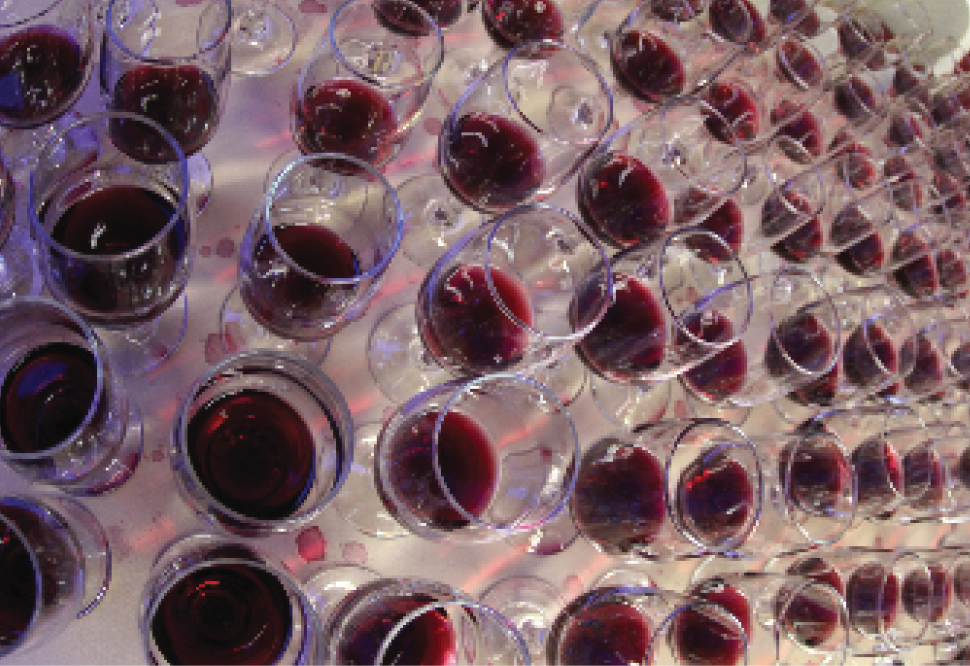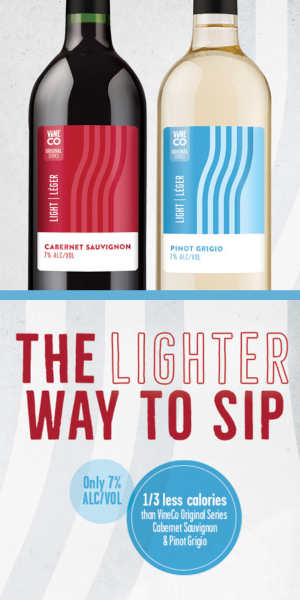 Home winemakers often resort to a little blending to improve their wines — to add a little more body, tweak the acid balance or deepen the color, or just because it takes one more gallon of something to fill that barrel. But many of the world’s great wines, and maybe even a higher percentage of the world’s pretty good wines, are designed as blends from the start.
Home winemakers often resort to a little blending to improve their wines — to add a little more body, tweak the acid balance or deepen the color, or just because it takes one more gallon of something to fill that barrel. But many of the world’s great wines, and maybe even a higher percentage of the world’s pretty good wines, are designed as blends from the start.
Think Bordeaux, where two grapes in the mix are a kind of minimum and four or five not uncommon. Take Châteauneuf-du-Pape, with 13 grape varieties (and counting) allowed in the soup. Or take Australia’s signature blend, Cabernet-Shiraz, sometimes known as Shiraz-Cabernet, an Oz staple with a lot to recommend it.
The first time I encountered this blend, early in the Australian invasion of US wine shelves, I thought it seemed rather odd. Why would you blend two big wines, each capable of standing on its own? Wouldn’t that make something overly heavy, clumsy, fighting with itself? But after some tasting, I figured out the underlying logic of this blend: the Cabernet Sauvignon provides the tannin structure and therefore the basis for longevity, and the Shiraz (Syrah for us Northern Hemisphereans) gives fleshy fruit from day one. The result is something a lot of wines claim, but often don’t really deliver: drinkability when young, right after release and the potential to mature in the bottle for several years.
In my experience, the combination of these two powerhouse wines is anything but heavy, not the overpowering sum of the parts that might be expected. Instead, Cab-Shiraz often comes across as lighter and livelier than either component. It’s as though the relative austerity of the young Cabernet diminishes the syrupiness of the Syrah, keeps it from being cloying — which some mass-market Aussie Shiraz can certainly be — while the fruitiness of the Syrah keeps the tannin from the Cabernet on a short leash. Somebody ought to cross these two grapes and see what happens.
Meantime, certainly for home winemakers, setting out to do a Cabernet-Shiraz blend is a great learning exercise in variety-specific winemaking. In many respects, making red wine is making red wine, but the nuances of difference in the grapes ultimately call for differences in cellar technique, as well as site selection and viticulture. Especially during the hectic week or ten days of fermentation, the common path to dryness has a lot of detours on one side or the other, in things like yeast preferences, fermentation temperature and the timing of pressing. Doing them side by side, even if a couple weeks apart, is a terrific hands-on lesson in steering wines in particular directions. In a short few days, the two approaches accomplish quite different things — and can end up in one happy marriage of a wine.
For the purposes of this article, the things that apply to all red wines — the importance of sanitation and clean equipment, the need for testing of basic grape and wine chemistry, frequent monitoring, topping off storage vessels, keeping SO2 levels in range — will get relatively scant attention. The focus will be on how this modern classic blend starts on two tracks and finally comes together on one — without crashing.
Grapes
I know it’s fashionable these days to insist on “picking on flavor, not on the numbers.” But some numbers are just not helpful for this particular wine style. Cab-Shiraz blends do rely on ripe flavors, but tend to fall apart and get blowsy and flabby once they get much past 14% alcohol, which means once the grapes get beyond 26 ºBrix. The 24.5– 26 ºBrix range is the right target. If one of the grapes is a little high, fine, it can average out; but if both are pushing the envelope, some dilution with acidulated water (6 grams of tartaric per liter of water) is recommended.
There is no way to know ahead of time the “perfect” blend of your batch of Cabernet and your batch of Syrah — you’d have to taste them as finished wines, except that you have to order the grapes first. Aiming for an even split, equal parts of each, is a pretty good bet, especially if you get enough grapes to have a couple gallons of each available for fine-tuning the blend.
This is a wine that certainly benefits down the road from barrel aging — maybe a year in a once-used 30-gallon (113-L) French or American barrel — which means buying enough grapes to fill at least a small barrel. But it can also work just fine in a carboy with some oak cubes. One useful variation on the project would be to get enough grapes for three carboys — a little over 100 pounds (45 kg) of each variety — and then compose one that’s 50:50, one that’s two-thirds Cabernet and one that’s two-thirds Syrah. You can always blend them together one more time for the final bottling, but enjoy the differences in the meantime.
Don’t let the fact you know it will grow up to be a blend fool you into thinking you can use second-rate grapes, as though somehow the process of combining the elements will overcome the flaws in the parts. You want grapes good enough to make good wine on their own. Get rid of any rotted grapes and other stray vegetable matter before crushing; this wine works best when it’s on the bright, clean side, not the earthy, stemmy side. The grape/wine chemistry should be in order — not just at reasonable sugar levels, but a pH down near 3.5 and acidity at or a little north of 6 grams per liter at the start of fermentation. If the pH is significantly high or the acidity low, fix it at the start.
For both grapes, crush as gently as possible, trying not to shred the skins or chew up the stems or crush any seeds. More and more, gentle crushing — up to and including no crushing at all, just destemming — is the dominant trend at the moment for most red winemaking, and it certainly helps with Cab-Shiraz, where harsh notes can really stick out. Right after crushing, do a small, preventive addition of SO2 — 25–50 parts per million—and consider a small dosage of lysozyme (50–100 parts per million) to fight off unwanted lactic bacterial activity. (However, be aware that lysozyme can interfere with malolactic fermentation, or MLF.)
Fermentation options
Here the paths start to diverge. Keep reminding yourself, the idea is to get structure out of the Cab, fruit out of the Syrah. For the Cabernet Sauvignon, Bordeaux-friendly yeast strains are good choices, since they have been selected for their ability to extract goodies from Cabernet and the rest of that family of gapes. The Bordeaux Red strain is an obvious choice; MT yeast advertises its ability to enhance wine structure; D80 is another good candidate.
For almost all red grapes, Australian winemakers tend to prefer front-loaded fermentations: getting the temperature up to its peak early in the fermentation cycle, then letting the must cool gradually as dryness approaches. The benefits of this approach are that the key phase of extraction of color and flavor compounds from the skins happens through temperature, while the ethanol level is still fairly low —instead of concentrating extraction at the end, when both temperature and ethanol (which favors tannin extraction) would be high. In this way, getting temperature to peak early is actually less aggressive than having it peak late, and since nearly all the goodies come out in the first few days, the option of pressing a bit early, a little before dryness, is available, limiting tannin accumulation.
In the Cabernet case, you’ll want to get the temperature up to 85 ºF (29 °C), even close to 90 ºF (32 °C), for a day or a day and a half, then slowly cool down. For most home winemakers, this means applying heat bands around the fermenters and perhaps covering the tops with other blankets to provide further insulation. With periodic punchdowns, the wine should be close to dryness in about a week.
For the Syrah, there is of course the eponymous Syrah yeast, along with another popular strain, D254. Many winemakers, commercial and amateur, have been experimenting with wines composed of batches made with D80 and other batches made with D254, the result at least potentially being a blended wine with more concentration, intensity and body. At the other extreme, if your goal is to maximize the fruity, youthful side of a Cab-Shiraz blend, try using something like RC212, often a Pinot Noir yeast choice. The Syrah target temperature would be a little lower, from 80 ºF (27 °C) to maybe 85 ºF (29 °C), again attained early in the fermentation cycle.
Another technique worth trying for the Syrah piece of this puzzle is délestage, or what the Australians call rack and return. The procedure, briefly, involves lifting the floating cap of the Syrah sometime in mid-fermentation, depositing it in another clean fermenter, and exposing both the transported cap and the remaining liquid to air for a short period, maybe 2–4 hours. Then pour the liquid back over the grapes in their new home, leaving a lot of the seeds behind, and re-commence the daily ritual of punchdowns.
The virtues of this deconstruction/reconstruction are twofold. First, it exposes everything to oxygen, which is useful at this stage of fermentation and helpful for getting the operation through to dryness. Second, it reduces the seed content in the mix. This part is a bit controversial: seed tannin has for some time gotten blamed for imparting harsh and bitter flavors to wine, though some recent research casts doubt on that. In any case, the oxygen boost is a plus, also helping pave the way for possible early pressing.
Pressing, Aging and Blending
The Cabernet should be pressed as soon as it reaches dryness, measured by a hydrometer. The Syrah, on the other hand, should probably be pressed slightly early, between 2–5 ºBrix, and allowed to finish fermentation in carboys (or barrels) with airlocks. The same logic again: get all the structure you can from the Cab, get the fruit and dodge the tannins and any late over-extraction from the Syrah.
Since this is a planned blend, the sooner the parts get together, the better—the better for settling the overall wine chemistry, and the better for being able to taste and smell what’s in the pipeline as a whole wine. And all of the wine, separately or together, needs to get inoculated for a malolactic fermentation (MLF) right after fermentation. The sooner the malolactic starts, the sooner it finishes, and the sooner you can do a major sulfur dioxide addition to protect the wine from spoilage.
My approach here has been to press each wine into carboys, inoculate with malolactic starter bacteria, let everything settle a few days so the gross sludge can hit bottom, and then rack a draft blend into barrel. Starting with a 50:50 blend is fine, with a small amount of each wine reserved for tweaking and topping over time. If you are doing this on a carboy scale, it still helps to rack the wine off the gross lees before combining.
You can choose to make the blend later on, when both wines have developed a bit more. This can sometimes offer more control of the blending proportions, based on blending trials, but gives the wine less time to come together and perhaps less time in barrel.
Here’s the place to explain how I got into this almost by accident. From the 2006 harvest, I had a couple gallons of Cabernet left over from a Bordeaux blend, and I always have some Syrah around on general principle. Late in the game, I put them together in a carboy, tossed in some oak cubes, more or less forgot about it — and ended up with two cases of very tasty wine. Which inspired me to do the project on purpose in 2008, filling a 30-gallon (113-L) barrel with 15 gallons (57 L) of each, from the same grape sources as the 2006 trial balloon.
A month or two after composing the draft blend, test for malolactic completion, as well as for pH and total acidity. Make any necessary acid adjustments, and hit the blend with SO2 at a level corresponding to the wine’s post-processing pH.
Cab-Shiraz blends benefit from moderate amounts of oak, whether from cubes or barrels. You don’t want to make a lumber-driven wine, but the density of these two grapes can soak up some oak flavors without getting lost in them. A one-year-old barrel is just about right, or an older, more neutral barrel with some chips added. French oak is gentler, American oak more forward, and both are fine for this wine. In the carboy version, try 4.0 ounces (113 g) of cubes in a 5.0-gallon (19-L) container for two or three months, and then refresh the oak at racking time if a bit more oak seems appropriate.
Finally, this blend is a good candidate for bâtonnage, lees stirring. Stirring lees once a week in barrels or carboys for several months helps promote autolysis of the spent yeast, adding especially textural compounds to the developing wine. Mouthfeel can also be enhanced by adding various yeast-derived preparations and packaged tannin, but unless your lees are of the stinky persuasion, which have to be removed from the wine, stirring your own is a much simpler way to go.
Finishing
Taste the wine as it develops. Look out for emerging faults — volatile acidity, reductive aromas — and deal with those problems promptly. See how the balance of acid, oak, tannin, alcohol and fruit is coming along and adjust things as needed. After a few months, if it’s clear the blend needs some more Cab or some more Syrah, and you have some available, blend it in. If the blend still seems too roughly tannic, which is unlikely, consider a light fining to smooth the rough edges.
After a few months, the logic of this blend should start showing through — a softer and more accessible wine than most Cabernets in their youth, more “grown up” than many New World Syrahs tend to be early on. All of this the result of less than two weeks of properly handled fermentation. If your wine is maturing in small vessels, it should be ready to bottle a year from harvest. Light (5 micron) filtration will help give a clearer, more brilliant wine. Use standard bottling procedures — careful sanitation, a light final SO2 addition (25 ppm), and a fanciful “critter” on your label to carry on the Australian theme.
And then try and keep yourself and your friends from drinking all of it before it has a chance to age.





